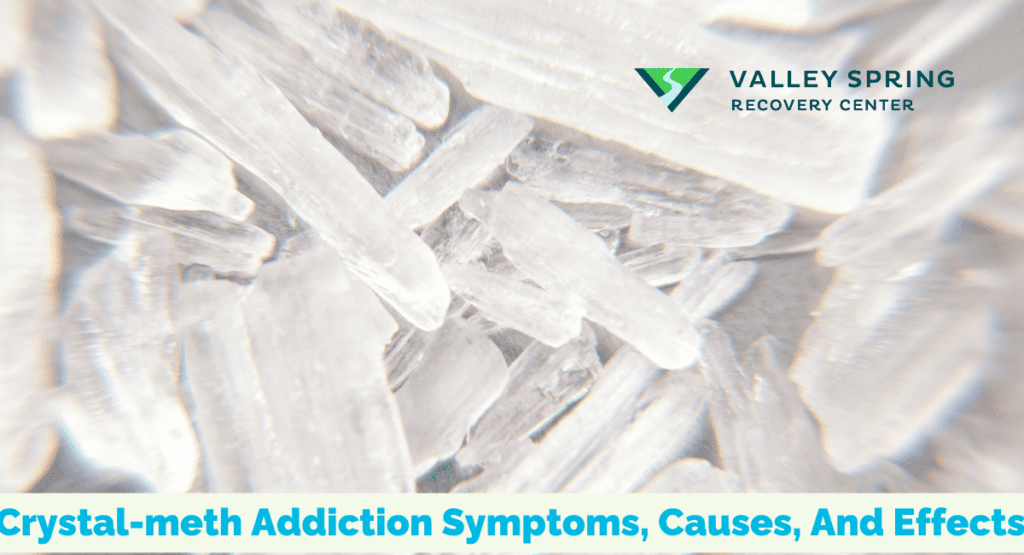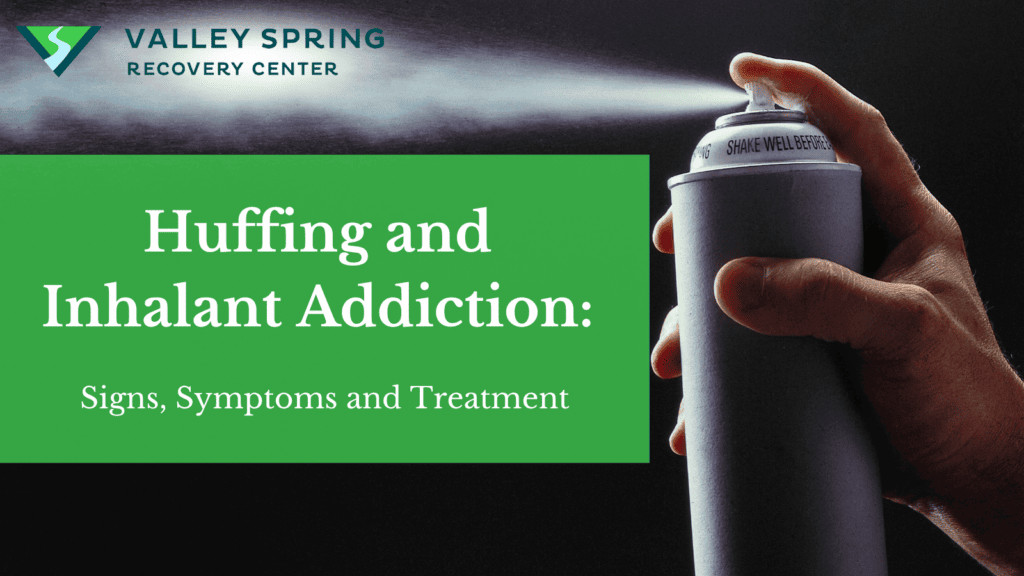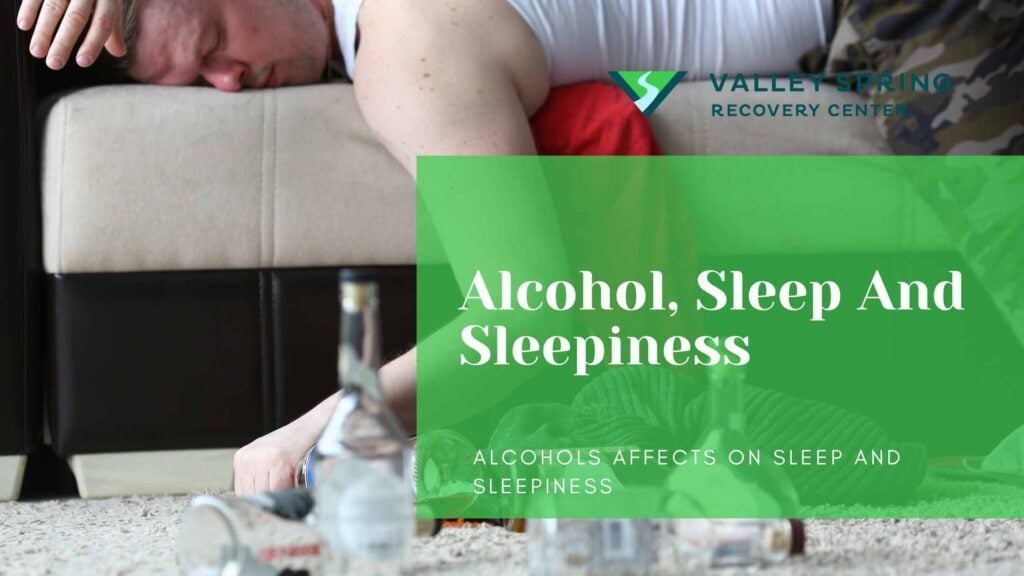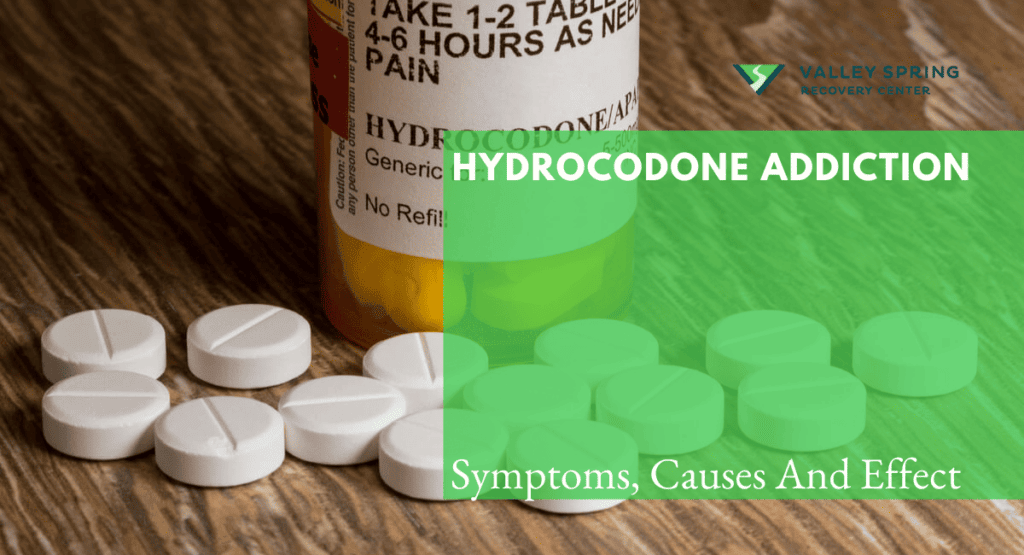Methamphetamine, commonly known as crystal meth, is a potent and highly addictive stimulant that impacts the central nervous system. Typically appearing as an odorless, white crystalline powder and occasionally with a blue tint, crystal meth has been used by approximately 2.5 million people, or 0.9% of the population, in the past 12 months in the U.S. According to the Drug Enforcement Administration’s 2021 report, its widespread availability is due to the ease with which it can be manufactured from common household items in small-scale laboratories, making it a particularly dangerous substance.
Methamphetamine addiction symptoms vary based on the amount and frequency of use and include extreme weight loss, dental problems (“meth mouth”), mood swings, paranoia, and neglect of personal hygiene, creating a downward spiral that demands urgent attention and care.
The causes of Methamphetamine addiction include stress, trauma, peer pressure, genetic predisposition, environmental factors, and or a desire for increased energy.
The effects of Methamphetamine addiction are devastating, leading to physical and mental deterioration, strained relationships, legal troubles, and an overwhelming sense of despair. Methamphetamine addiction affects daily life, and leads to dependence on the substance and uncomfortable withdrawal symptoms when cessation occurs.

This article has been enhanced with input from the Medical Director and Addiction Psychiatrist at Valley Spring Recovery Center, Dr. Michael Olla.
Check the end of each section for extra information from him.
What is Methamphetamine addiction?
Methamphetamine addiction is defined Methamphetamine addiction is defined as a chronic, relapsing disorder characterized by compulsive drug seeking and use despite adverse consequences where individuals become dependent on the powerful stimulant drug.
Meth addicts crave the rush and euphoria that comes from using the drug even though the negative effects on physical, mental, and overall well-being are catastrophic.
In 2021, it was estimated that over 1.62 million Americans used methamphetamine in the last year, highlighting the alarming prevalence of this issue. Methamphetamine addiction wreaks havoc by causing physical and mental health problems, straining relationships, and often leading to legal issues. (SAMHSA)
This addiction typically manifests with a range of symptoms, including extreme weight loss, dental issues (referred to as “meth mouth”), paranoia, mood swings, and neglect of personal hygiene. You experience a false sense of increased energy and alertness, followed by a severe crash, intensifying the cycle of use.
What are the signs and symptoms of crystal meth addiction?
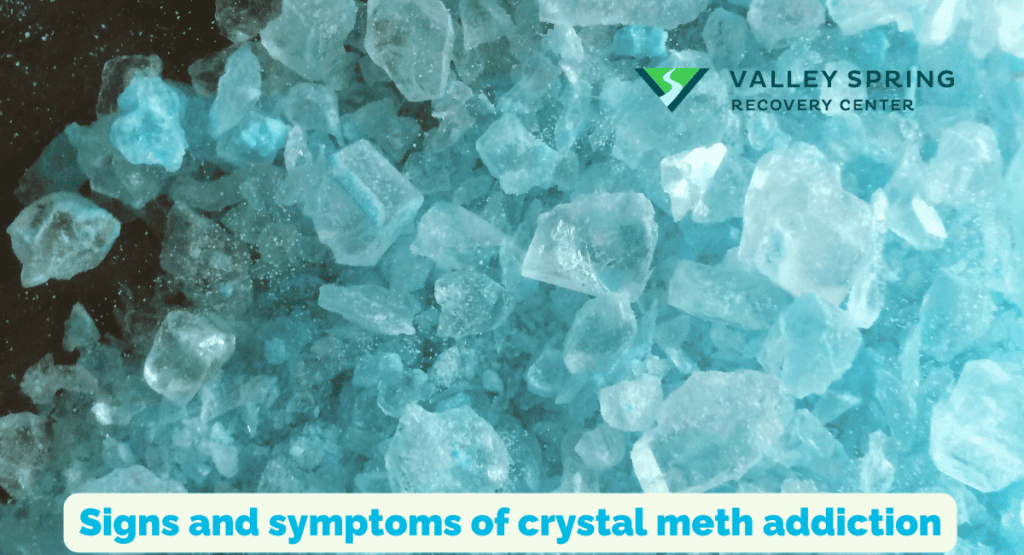
The signs and symptoms of methamphetamine use are easy to spot compared to other drugs because of their drastic impact on physical, mental, and emotional well-being. The signs and symptoms of crystal meth addiction are listed below:
- Drastic Weight Loss: You or your loved one may experience rapid and unexplained weight loss due to reduced appetite.
- Dental Problems (“Meth Mouth”): Severe dental issues like tooth decay, gum disease, and teeth grinding become apparent.
- Mood Swings: You may notice frequent and extreme mood swings, including irritability, aggression, and violent outbursts.
- Paranoia and Anxiety: An overwhelming sense of paranoia, anxiety, and fear, often accompanied by hallucinations.
- Neglected Hygiene: A decline in personal hygiene and grooming habits, leading to poor appearance and body odor.
- Skin Sores: After a prolonged misuse of crystal meth, you will begin to notice skin sores, many of which may result in you “picking” at the skin due to hallucinations or hallucinatory insects.
- Insomnia: Chronic sleep disturbances that can leave you staying awake for days on end.
- Tremors and Twitching: Noticeable physical symptoms like tremors, twitching, and restlessness.
- Hyperactivity: You’ll experience an unusually high level of energy, restlessness, and talkativeness, followed by an extreme drop in energy and strength.
- Financial Problems: A rapid depletion of financial resources, as crystal meth can be expensive, leading to debt or theft.
- Social Isolation: Withdrawal from friends and family, as the addiction consumes more of your or your loved one’s time and focus.
- Legal Issues: Involvement in illegal activities to obtain or distribute the drug, resulting in legal problems.
Crystal meth addiction manifests in notably severe physical and psychological symptoms that can rapidly deteriorate one’s quality of life,” explains Dr. Michael Olla, Medical Director at Valley Spring Recovery Center. “From dramatic weight loss and the notorious ‘meth mouth’ to profound mood swings and persistent paranoia, these indicators are not only distressing but also a call to action for immediate medical intervention. Early recognition and treatment are crucial to prevent long-term damage and begin the journey towards recovery.
Dr. Michael Olla, Medical Director at Valley Spring Recovery Center
Recognizing these signs and symptoms is crucial for early intervention and seeking help for crystal meth addiction. It’s essential to approach this issue with care and support, whether you’re the one facing addiction or you’re concerned about a loved one.
What are the effects of methamphetamine addiction?

Methamphetamine addiction exerts a comprehensive and severe impact across physical, mental, and behavioral dimensions, manifesting a wide range of destructive effects that impair overall health and social functioning.
What Are The Physical Effects of Methamphetamine Addiction?
The 4 physical effects of methamphetamine abuse are listed below according to the Drug Enforcement Administration’s Diversion Control Division, Drug & Chemical Evaluation Section, December 2022.
- Severe Deterioration: Chronic use of meth leads to significant physical decline, including extreme weight loss and malnutrition.
- Dental Health: “Meth mouth,” characterized by severe tooth decay and gum disease, is prevalent among users.
- Skin and Health Issues: Users may develop skin abscesses and are at increased risk for diseases like Parkinson’s due to neurotoxicity. Intravenous use heightens the risk of contracting bloodborne pathogens like hepatitis C.
- Neurological Damage: High doses and chronic use can lead to neurotoxic effects, damaging neurons and blood vessels. This contributes to a heightened risk of cardiovascular collapse, including stroke and heart attacks.
How does methamphetamine use impact dental health and lead to “meth mouth”?
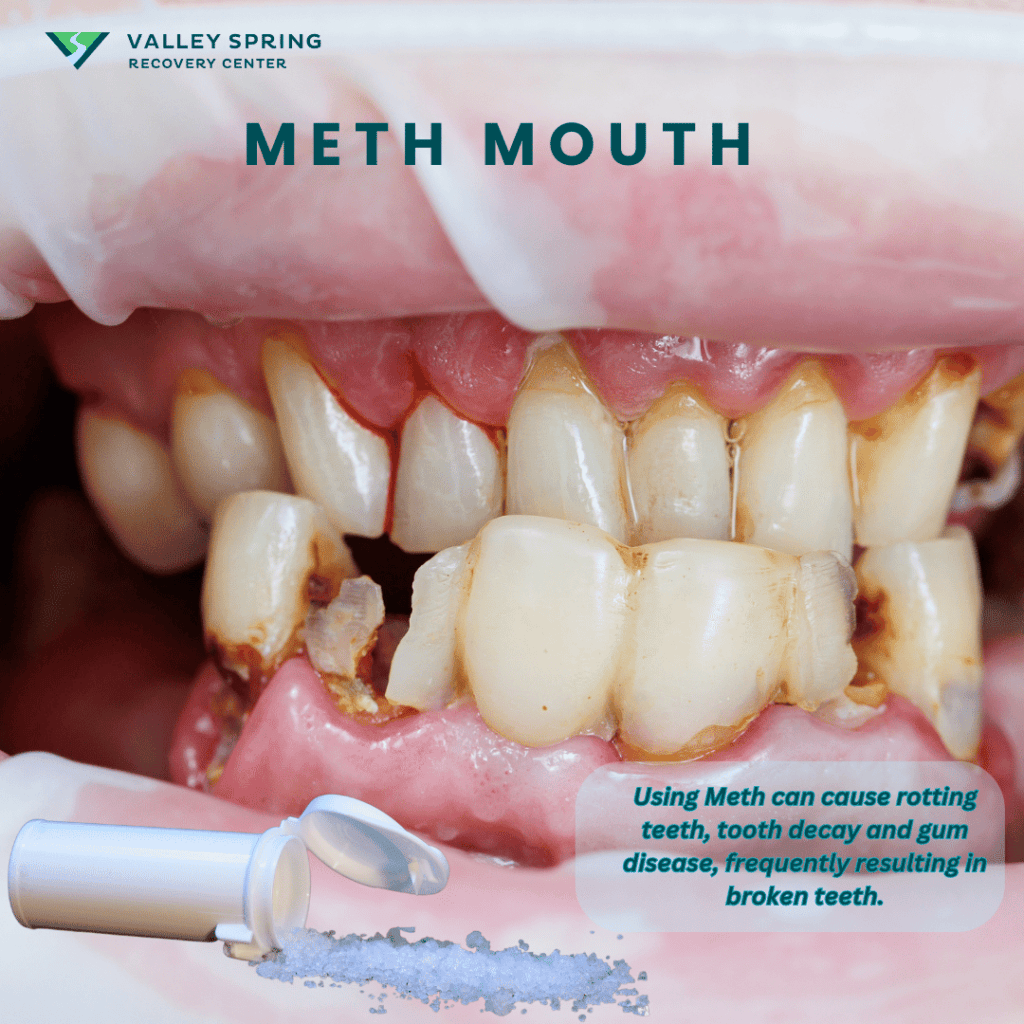
Crystal meth has a profound negative effect on dental health and hygiene. The slang phrase ‘Meth Mouth’ became popular and is used to describe rotting teeth which occurs frequently in crystal meth addicts. It’s common for regular meth users to experience tooth decay and gum disease, which often causes teeth to break or fall out. The Journal of the American Dental Association examined of the mouths of 571 methamphetamine users which revealed the following dental problems:
- 96% had cavities
- 58% had untreated tooth decay
- 31% had six or more missing teeth
Treatment for meth mouth may involve intensive dental work, tooth replacements, cavity fillings, and even dentures.
What are the Mental and Cognitive Effects?
The 3 mental and cognitive effects of meth use are listed below.
- Psychological Distress: Methamphetamine use can induce paranoia, and psychosis, including delusions (e.g., feeling insects crawling on the skin), and exacerbate existing mental health disorders such as anxiety and depression.
- Cognitive Decline: The drug impairs crucial cognitive functions, affecting memory, attention, decision-making, and verbal abilities. While some cognitive functions may recover after cessation, others, particularly those associated with dopamine circuits, may suffer long-term or permanent damage.
- Behavioral Changes: Long-term meth use is associated with aggressive and violent behavior, often directed at close individuals like family members.
How does meth affect the brain?
Crystal meth profoundly affects your brain by altering its natural chemistry. Research conducted in 2021 showed that methamphetamines release an excessive amount of dopamine, a neurotransmitter associated with pleasure and reward centers of the brain, flooding your brain’s synapses. (NIDA)
This surge in dopamine creates intense euphoria, but with repeated use, your brain becomes less responsive to it, leading to tolerance. As a result, you’ll need more of the drug to achieve the same high, which increases the risk of addiction.
Additionally, methamphetamine damages the brain’s dopamine-producing neurons, impairing your ability to experience pleasure from anything other than the drug itself. This can lead to severe depression and anhedonia, a condition where you find no joy in previously enjoyable activities.
Long-term meth use also harms cognitive functions, affecting memory, decision-making, and impulse control. It can even lead to structural changes in your brain. Understanding these effects is crucial for seeking help and breaking free from the cycle of addiction.
What are the Behavioral and Social Consequences of Methamphetamine Use?
Methamphetamine use leads to social withdrawal, legal and financial repercussions, and a high risk of potentially fatal overdose.
- Social Withdrawal: Addiction leads to prioritizing drug use over relationships, resulting in profound loneliness and social isolation.
- Legal and Financial Repercussions: Engaging in illegal activities to fund the addiction can lead to significant legal consequences, financial ruin, and potential incarceration.
- Risk of Overdose: Methamphetamine poses a substantial risk of overdose, which can be fatal without immediate medical intervention.
What are the causes of crystal meth addiction?
The causes of crystal meth addiction are multifaceted, involving stress and trauma, peer pressure, a desire for increased energy, curiosity, genetic susceptibility, underlying mental health issues, environmental influences, and its relative ease of accessibility.
- Stress and Trauma: You may have turned to meth as a way to cope with overwhelming stress or traumatic experiences. This is one of the leading causes of any kind of addiction.
- Peer Pressure: Pressure from friends or acquaintances who use the drug can make it challenging to resist.
- Desire for Increased Energy: Crystal meth initially provides a burst of energy and focus, which might have been appealing.
- Curiosity: Some individuals try meth out of curiosity, unaware of its addictive potential.
- Genetic Factors: Genetics can play a role, as addiction can run in families, making you more susceptible.
- Underlying Mental Health Issues: If you struggle with mental health issues like depression or anxiety, you might turn to meth as a way to self-medicate.
- Environmental Factors: Growing up in an environment where drug use is normalized or prevalent can increase the likelihood of addiction.
- Accessibility: Meth can be manufactured with over-the-counter pharmaceuticals and is created in a laboratory which makes it easier to create and obtain when compared to other substances.
What are the withdrawal symptoms of crystal meth?
Withdrawing from crystal meth addiction can be challenging, and various physical and psychological symptoms may occur. If you or a loved one are going through this process, here are some common withdrawal symptoms to be aware of:
| Withdrawal Symptom | Description |
|---|---|
| Intense Cravings | Strong, persistent desires for the drug can be overwhelming. |
| Fatigue | Feeling extremely tired and lacking energy is common during withdrawal. |
| Depression | Deep sadness, hopelessness, and a loss of interest in activities. |
| Anxiety | Feelings of anxiety, restlessness, and nervousness are frequent. |
| Irritability | Becoming easily agitated and irritable. |
| Sleep Disturbances | Insomnia or hypersomnia (excessive sleep) can disrupt your sleep patterns. |
| Increased Appetite | Craving for high-calorie foods is common, which can lead to weight gain. |
| Paranoia | Some individuals experience heightened paranoia or anxiety during withdrawal. |
| Hallucinations | In severe cases, auditory or visual hallucinations may occur. |
| Psychomotor Agitation | Restlessness, fidgeting, and an inability to sit still are common. |
Spring Valley Recovery Is Only One Phonecall Away
What are the Treatment Options for Methamphetamine Addiction?

Effective treatment options for methamphetamine addiction that support recovery and manage dependency with precision and care are listed below.
- Detoxification: Start with a medically supervised detox program to safely manage withdrawal symptoms, which can be intense.
- Inpatient Rehabilitation: Research has shown that inpatient treatment programs provide a structured and supportive environment, often lasting 30-90 days, where you can focus on recovery.
- Outpatient Programs: These offer flexibility, allowing you to attend IOP therapy and counseling while living at home, but they require a strong support system.
- Behavioral Therapy: Cognitive-Behavioral Therapy (CBT) and Contingency Management are proven to be effective in addressing meth addiction’s psychological aspects.
- Support Groups: Participate in support groups like Narcotics Anonymous (NA) or Crystal Meth Anonymous (CMA) for ongoing encouragement and shared experiences.
- Medication-Assisted Treatment (MAT): Though not a primary treatment, some medications can help reduce cravings and ease the recovery process.
- Family Therapy: Involving family members can strengthen the support system and address any family dynamics contributing to addiction.
- Aftercare: Research emphasizes the importance of aftercare programs to prevent relapse, offering ongoing support and relapse prevention strategies.
- Matrix Model: The matrix model was developed in response to the crack cocaine epidemic to treat stimulant abuse like methamphetamine and serves as a comprehensive care model for stimulant addiction rehabilitation.
Addressing methamphetamine addiction requires a deep understanding of its complex nature, it is not merely about curbing the use of the drug; it’s about comprehensive rehabilitation that focuses on healing the individual holistically, recognizing the profound impact this substance has on both the brain and behavior.
Dr. Michael Olla, Medical Director at Valley Spring Recovery Center.
Recovering from methamphetamine addiction requires a comprehensive approach that addresses the multi-faceted impacts of the drug. Treatment typically involves a combination of medical detox, behavioral therapies, and support groups. Long-term recovery may also necessitate ongoing mental health support to manage the residual psychological effects and prevent relapse.
What is the Effectiveness of the Matrix Model in Treating Methamphetamine Addiction?
The Matrix Model effectively treats methamphetamine addiction by integrating several therapeutic elements. This comprehensive approach includes cognitive-behavioral therapy, individual counseling, family education, and relapse prevention strategies. By focusing on both behavioral and psychological aspects of addiction, the Matrix Model provides a multifaceted treatment plan that addresses the complex nature of methamphetamine dependency.
What Does Crystal Meth Anonymous Do Differently Than Alcoholics Anonymous?
Crystal Meth Anonymous or CMA for short, is built on the foundation of the 12 steps of Alcoholics Anonymous written by Bill Wilson and Dr. Bob from which millions of people have found sobriety. The principles of CMA are similar to that of AA but are different because CMA exists to treat the type of drug addicts that are addicted to crystal meth offering its members are able to find deeper camaraderie through their shared experience with meth. Similar offshoots of AA have been developed for different types of addicts, for instance, cocaine addicts formed Cocaine Anonymous (CA).
Where to find treatment for Methamphetamine addiction?
Finding treatment for methamphetamine addiction involves several resources and steps to ensure you access appropriate and effective care:
- Local Healthcare Providers: Start with your primary care physician who can provide a referral to addiction specialists or treatment facilities.
- Substance Abuse and Mental Health Services Administration (SAMHSA): Utilize the SAMHSA National Helpline at 1-800-662-HELP (4357) for free, confidential assistance 24/7, or visit their online treatment locator to find treatment facilities near you.
- Insurance Provider: Contact your insurance company to get a list of covered addiction treatment services and facilities.
- Local Support Groups: Consider groups like Narcotics Anonymous (NA) or Crystal Meth Anonymous (CMA), which offer support and resources for individuals struggling with drug addiction.
- State and Local Health Departments: They can provide information about state-funded treatment programs, especially if you are without insurance or have financial constraints.
- Hospitals and Clinics: Many hospitals have associated outpatient or inpatient detox and rehabilitation programs and can direct you to further substance abuse treatment resources.
It’s important to seek a treatment program that incorporates a comprehensive approach to care, including detoxification, behavioral counseling, medication (if applicable), and aftercare planning to support long-term recovery. Additionally, Valley Spring Recovery Center offers methamphetamine addiction treatment in New Jersey. If you or a loved one are struggling with substance use disorder, help is available.
What are the different forms of Methamphetamines?
Methamphetamine, a highly addictive and potent central nervous system stimulant, can be found in several forms including crystalline “ice,” powder, tablets or pills, and liquid, each with varying appearances and street names, reflecting its preparation and purity levels. This diversity underlines the drug’s adaptability in illicit markets and its potential for abuse and harm.
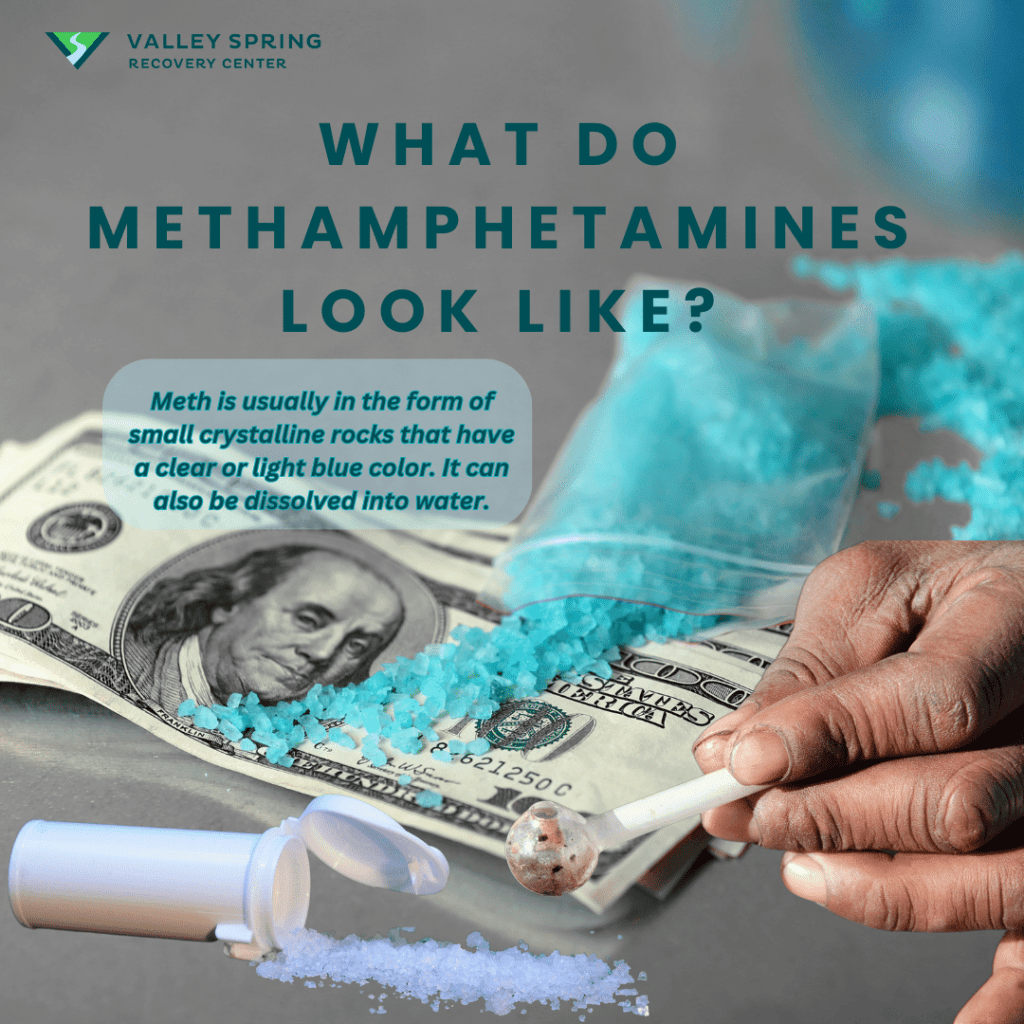
- Crystal: This is the most well-known form, consisting of translucent, bluish-white crystals. It’s often referred to as “ice” due to its appearance.
- Powder: Methamphetamine can also be found in a powdered form, resembling a fine, white, or off-white powder. It’s sometimes called “crystal powder” or simply “meth.”
- Tablets or Pills: In some cases, methamphetamine is pressed into tablets or pills, which are often colored and stamped with various logos or designs.
- Liquid: Methamphetamine can also be dissolved in a liquid, making it easier to ingest or inject.
- Crystal Meth Mixed with Other Substances: Sometimes, crystal meth is mixed or “cut” with other substances to increase profits for illegal manufacturers. This can result in varying appearances and effects.
| Form | Description | Common Names |
|---|---|---|
| Crystal | Translucent, bluish-white crystals. | “Ice” “crank” |
| Powder | Fine, white or off-white powder. | Methamphetamine is pressed into tablets or pills, often colored and stamped with various logos. |
| Tablets/Pills | Methamphetamine pressed into tablets or pills, often colored and stamped with various logos. | (Various based on logo) |
| Liquid | Methamphetamine dissolved in a liquid form. | (speed, Wash) |
| Mixed | Crystal meth mixed with other substances to increase profits, resulting in varying appearances and effects. | (Depends on the substances used, some names include speedballs) |
Regardless of the form, it’s essential to understand that all forms of crystal meth can be highly addictive and harmful when misused. The substance itself remains the same – methamphetamine – and carries the same risks according to the National Alcohol & Drug Knowledgebase.
Spring Valley Recovery Is Only One Phonecall Away
What Are The Different Slang Names For Methamphetamine Addiction?
Methamphetamine is known by a wide array of slang names that vary regionally and culturally, reflecting its pervasive impact across diverse communities. Here are some of the less commonly known and imaginative slang terms for methamphetamine, demonstrating the drug’s global reach and the creative language users and dealers employ:
- Ice – Reflects the clear, crystal-like appearance of high-purity methamphetamine.
- Crystal – Short for crystal meth, emphasizing its shiny, glass-like quality.
- Crystal Meth – The full name often used in both media and casual speech.
- Glass – Another term that highlights the drug’s clear, crystalline appearance.
- Crank – A term that’s been used historically, especially in motorcycle gangs.
- Speed – Refers to the stimulating effects that increase alertness and physical activity.
- Tina Turner – A playful reference to energy and high tempo, commonly used in urban areas.
- Biker’s Coffee – Used among motorcycle groups, highlighting its use for prolonged energy.
- Ice Cap – A term that plays on the drug’s appearance resembling ice crystals, used in colder regions.
- Zoomer – A nod to the drug’s effect of increased alertness and speed, popular in fast-paced urban environments.
- Crystal Cowboy – Found in rural areas, particularly where rodeo or cowboy culture is prevalent.
- Glass Slipper – A fanciful term that might be used in contexts or areas with a focus on fantasy or escapism.
- Moon Rocks – Referring to its crystalline form and its less refined, rock-like appearance.
- Stardust – An imaginative term that highlights the euphoric and out-of-this-world experience of the high.
- Rocket Fuel – Used to denote the powerful surge of energy it provides, especially in contexts involving labor-intensive work.
- Blue Belle – This might be used in areas where the drug is tinted due to specific manufacturing processes.
| Slang Name | Description |
|---|---|
| Ice | Reflects the clear, crystal-like appearance of high-purity methamphetamine. |
| Crystal | Short for crystal meth, emphasizing its shiny, glass-like quality. |
| Crystal Meth | The full name often used in both media and casual speech. |
| Glass | Highlights the drug’s clear, crystalline appearance. |
| Crank | Historically used, especially in motorcycle gangs. |
| Speed | Refers to the stimulating effects that increase alertness and physical activity. |
| Tina Turner | A playful reference to energy and high tempo, commonly used in urban areas. |
| Biker’s Coffee | Used among motorcycle groups, highlighting its use for prolonged energy. |
| Ice Cap | Plays on the drug’s appearance resembling ice crystals, used in colder regions. |
| Zoomer | A nod to the drug’s effect of increased alertness and speed, popular in fast-paced urban environments. |
| Crystal Cowboy | Found in rural areas, particularly where rodeo or cowboy culture is prevalent. |
| Glass Slipper | A fanciful term that might be used in contexts or areas with a focus on fantasy or escapism. |
| Moon Rocks | Refers to its crystalline form and its less refined, rock-like appearance. |
| Stardust | Highlights the euphoric and out-of-this-world experience of the high. |
| Rocket Fuel | Used to denote the powerful surge of energy it provides, especially in contexts involving labor-intensive work. |
| Blue Belle | Might be used in areas where the drug is tinted due to specific manufacturing processes. |
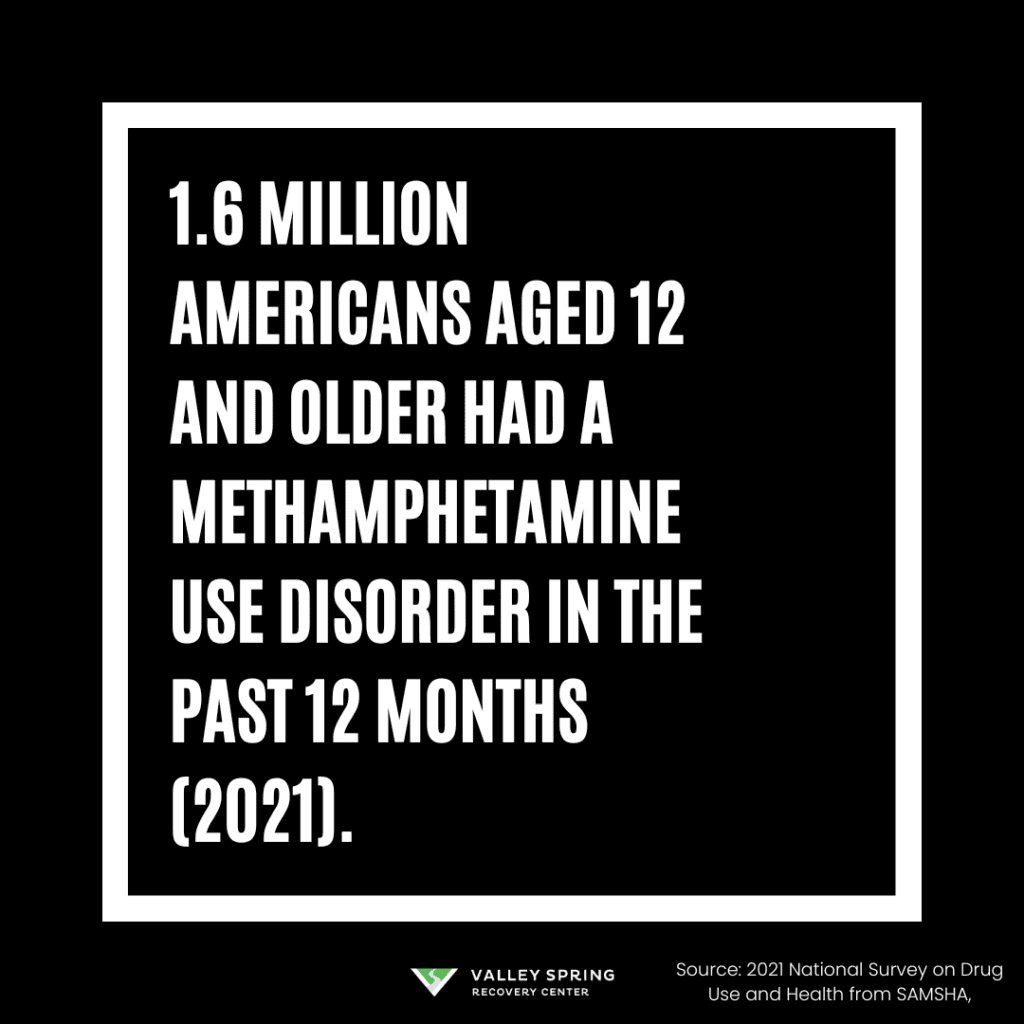
What Are the Facts and Statistics on the Prevalence of Crystal Methamphetamine Abuse?
The global crisis of methamphetamine abuse is underscored by data from the United Nations Office on Drugs and Crime, which indicates that approximately 500 metric tons of amphetamine-type stimulants were produced in 2015. Worldwide, there are around 24.7 million abusers of these stimulants, with numbers continuing to rise into 2018. Methamphetamine, often included under the broader category of amphetamine-type stimulants, shows its most significant abuse rates in parts of Asia, Europe, Australia, and the United States.
According to the 2021 National Survey on Drug Use and Health from SAMHSA, the number of individuals in the United States over 12 years old who reported methamphetamine use includes approximately 16.83 million for lifetime use, 2.55 million for use in the past year, and 1.62 million for use in the past month.
A February 2023 study by the National Institute on Drug Abuse (NIDA) reported that about 32,537 people succumbed to overdoses involving crystal meth in 2021, highlighting a significant national epidemic. This rising trend in methamphetamine use affects diverse demographic groups across the country, transcending age, gender, and socioeconomic boundaries.
In Europe, methamphetamine production is notably concentrated in the Czech Republic, with other significant production reported in the Netherlands, Lithuania, and Bulgaria. Law enforcement data from the European Drug Report of 2017 highlight cocaine as the predominant stimulant seized in western and southern Europe, with methamphetamine more common in eastern regions like the Czech Republic, Lithuania, Latvia, and Slovakia. Methamphetamine use, while overall low across Europe, finds its highest concentrations in the Czech Republic, Slovakia, East Germany, and some Finnish cities, emphasizing the localized nature of this epidemic.
Where and how is methamphetamine typically manufactured and produced?
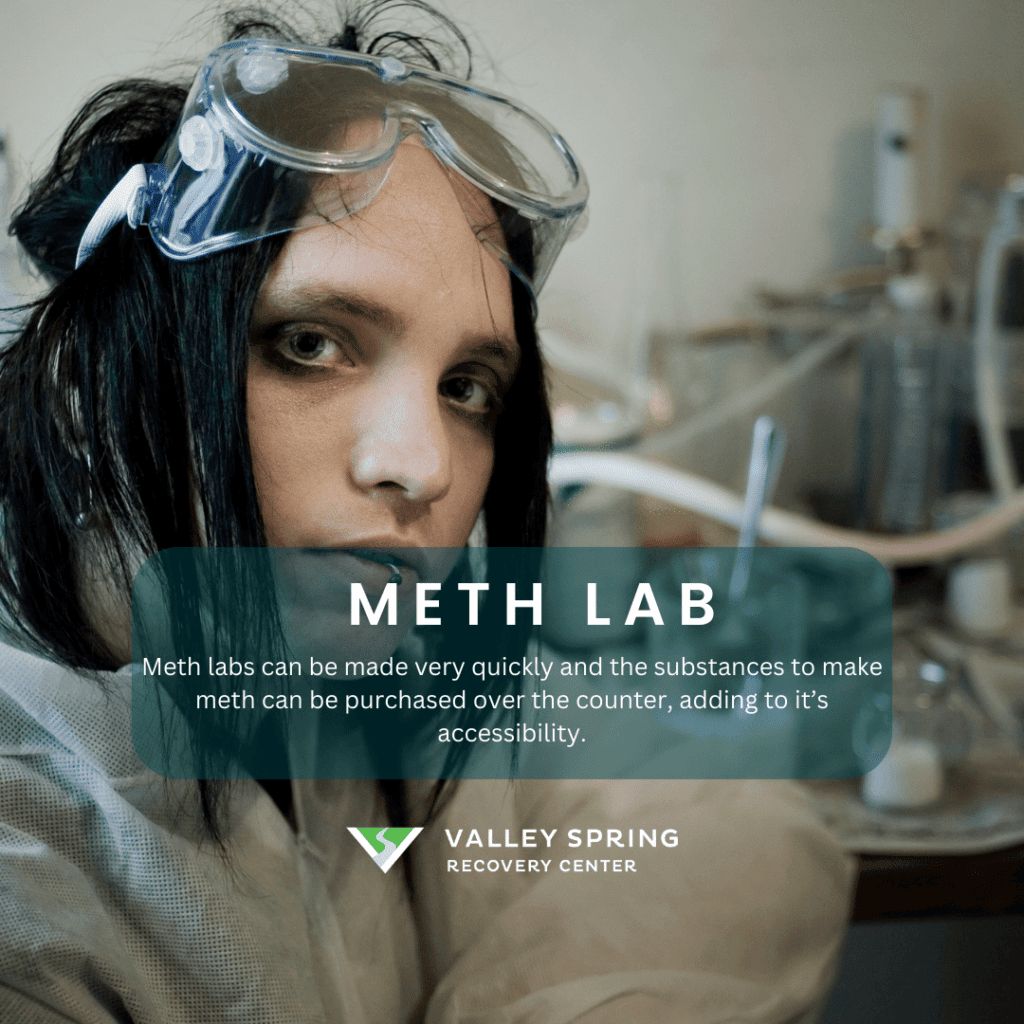
Methamphetamine, commonly known as meth, is illegally manufactured in clandestine labs across various parts of the world. According to a Statista 2023 study, Methamphetamine manufacturing Incidents have trended down over the last decade, peaking at 23,73 incidents in 2004 to 890 in 2019. These labs can range from sophisticated setups to makeshift operations in homes, garages, or remote locations. In the United States, meth labs have been found in rural, suburban, and urban areas. Internationally, large-scale production occurs in countries like Mexico. It’s important to note that the production of meth is illegal and highly dangerous, posing risks of explosion, toxic fumes, and environmental hazards.
Crystal meth addiction is a devastating condition marked by dependence on the powerful stimulant drug methamphetamine. It affects both the body and mind, leading to a range of physical and mental health issues. Crystal meth addiction isn’t showing any signs of decline, however, law enforcement has been able to limit the amount of meth manufacturing facilities in the united states with less than 1,000 meth labs found in 2019, showing a considerable decline from almost 25,000 in 2004 according to Statistia.
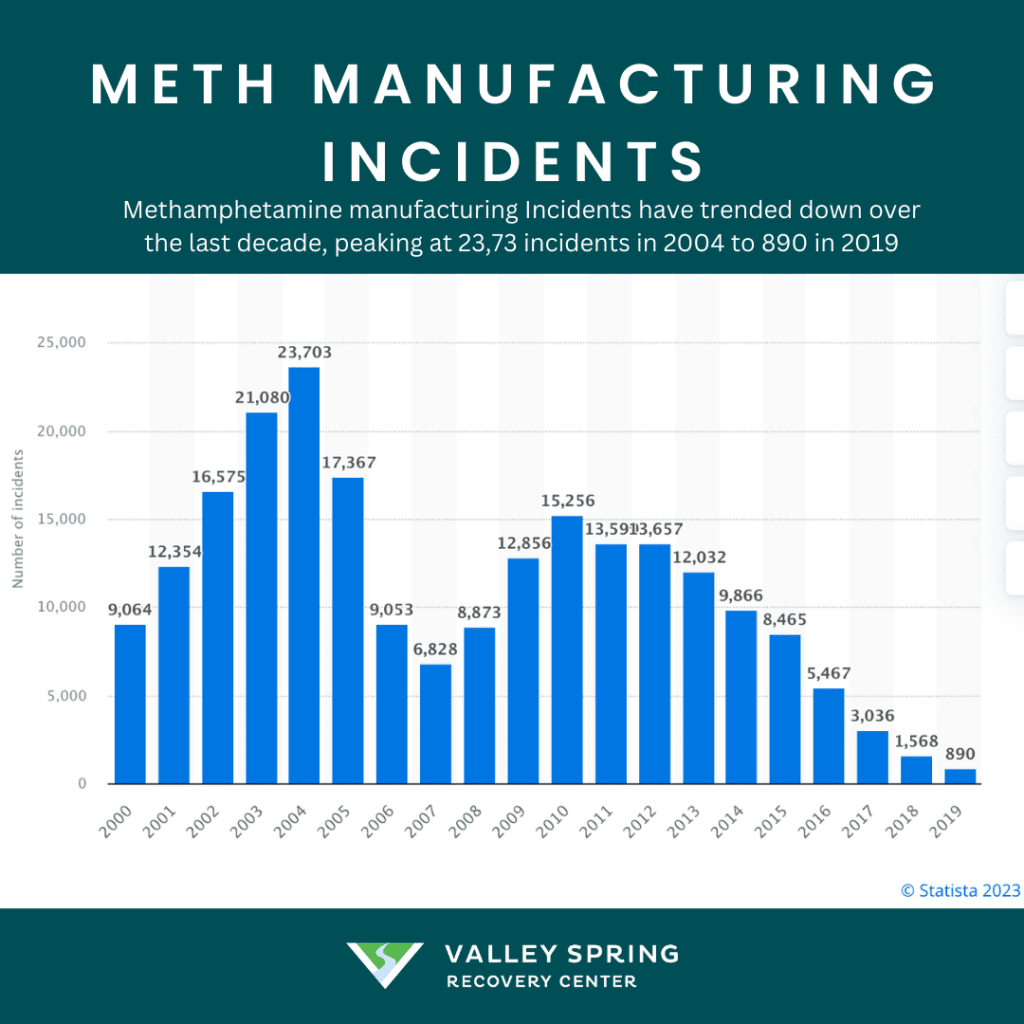
What Role Does Crystal Meth Play in the Global Drug Crisis?
Crystal methamphetamine, commonly known as crystal meth, is a highly addictive stimulant that significantly contributes to the global drug crisis. Its widespread production and distribution have profound impacts across international borders, challenging law enforcement and influencing drug policy debates. As governments and international agencies intensify efforts to curtail its spread, strategies include strengthening law enforcement, enhancing global cooperation, and implementing harm reduction measures. The debate often centers on addressing addiction as a public health issue rather than a criminal one, advocating for increased access to treatment and prevention programs. The transnational nature of crystal meth production complicates efforts to dismantle trafficking networks, necessitating coordinated international responses. The drug not only devastates individual health but also imposes heavy social and economic burdens, underscoring the need for a comprehensive approach to combat the crystal meth epidemic effectively.
What Are The Law Enforcement Efforts and Legal Implications of Methamphetamine?
Crystal methamphetamine, commonly known as crystal meth, is an illicit drug that poses significant risks to individuals and communities. Law enforcement agencies play a crucial role in combating the production and distribution of this dangerous substance.
What Is The Role of Law Enforcement Agencies In Stopping Methamphetamine Distribution and Use?
Law enforcement agencies work tirelessly to identify and dismantle crystal methamphetamine production and distribution networks. They conduct investigations, gather evidence, and arrest individuals involved in the illicit trade of this highly addictive drug.
These agencies collaborate with local, state, and federal authorities, implementing strategies to disrupt the supply chain of crystal methamphetamine. This involves targeting drug manufacturing laboratories, dismantling trafficking networks, and intercepting shipments to prevent the drug from reaching its intended destinations.
Law enforcement efforts also focus on apprehending individuals involved in the sale and distribution of crystal methamphetamine, thereby limiting its availability in communities. These efforts not only aim to disrupt drug trade but also serve as a deterrent to potential offenders.
What Are The Drug Control Policies and Implications For meth?
Drug control policies are put in place to regulate the production, distribution, and possession of crystal methamphetamine. These policies aim to reduce the availability and use of the drug, as well as to protect public health and safety.
While drug control policies vary across jurisdictions, they generally aim to enforce strict penalties for crystal methamphetamine-related offenses. These penalties include imprisonment, fines, asset forfeiture, and mandatory rehabilitation programs.
Drug control policies also provide resources for prevention, education, and treatment initiatives. They support initiatives that aim to prevent drug use, educate the public about the risks of crystal methamphetamine, and provide treatment and rehabilitation options for individuals struggling with addiction.
What Are The Legal Consequences For Using and Selling Methamphetamines?
The possession, manufacturing, and trafficking of crystal methamphetamine carry severe legal consequences. Possession of the drug, even in small quantities, can lead to criminal charges and penalties. Manufacturing crystal methamphetamine is considered a serious offense due to the dangerous nature of its production process.
Individuals involved in the trafficking of crystal methamphetamine face even harsher penalties. Trafficking charges can result in lengthy prison sentences and substantial fines, reflecting the severity of the drug’s impact on society.
It is important for individuals to be aware of the legal implications of crystal methamphetamine involvement and to understand the serious consequences that can result from engaging in illegal activities related to this illicit drug.
How are the effects of crystal meth addiction and cocaine different or similar?
Crystal meth addiction has a range of devastating effects on both the body and mind. Physically, it can lead to extreme weight loss, tooth decay commonly referred to as “meth mouth,” skin sores, increased heart rate, and hyperthermia, which is an elevated body temperature. Psychologically, crystal meth addiction can cause paranoia, hallucinations, anxiety, aggression, and cognitive deficits. Socially, it often leads to strained relationships, job loss, and legal issues.
Cocaine addiction also has its own set of detrimental effects. Physically, it can cause nosebleeds, especially if the substance is snorted, respiratory issues, increased heart rate, constricted blood vessels, and an elevated risk of stroke. Psychologically, cocaine addiction can lead to feelings of euphoria and increased energy but also results in irritability, anxiety, and paranoia. Much like crystal meth addiction, cocaine addiction can also lead to strained relationships, job loss, and legal troubles.
When it comes to similarities, both substances can lead to an increased heart rate and heightened levels of anxiety. Socially, addiction to either substance often results in strained relationships, job loss, and legal issues. Both substances are also highly addictive and can lead to severe withdrawal symptoms, making recovery a challenging process.
However, there are key differences between the two. Crystal meth addiction often leads to more severe physical deterioration, including conditions like “meth mouth” and skin sores, which are less common in cocaine addiction. Cocaine addiction, on the other hand, may result in nosebleeds and respiratory issues, which are less prevalent in meth addiction. Additionally, the psychological effects of meth, such as hallucinations and extreme paranoia, are generally more severe than those caused by cocaine.
Kristy Ashe
All author postsShare This Post

